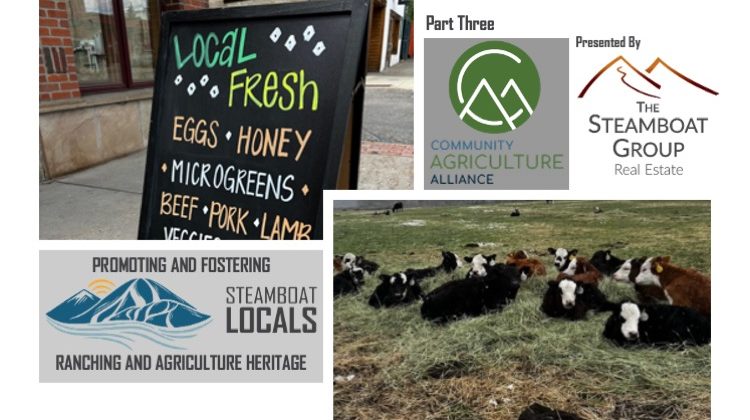
The Community Agriculture Alliance Builds Partnership, Awareness Surrounding Yampa Valley Food Systems
The Yampa Valley, since its settlement, has enjoyed a deep connection with food production.
Transitions since have led to a local non-profit group leading the way to ensure that heritage by supporting the agricultural community while also fostering connections between consumers and producers.
Katie Stanhope, who serves as the Yampa Valley Foods Manager for the Community Agriculture Alliance, is part of that organization’s movement to bolster ranching and farming, and awareness of it, in the region.
Courtesy Photo/Community Agriculture Alliance
Stanhope, who is originally from Montana, came to the Yampa Valley with her family when she was ten. In high school, she started working for a family who sold produce at the Steamboat Farmers Market, which led to her developing a fascination with agriculture and food systems. She felt a deep “pride” in selling Colorado-grown products, working directly with consumers, and learning more about family- and locally-based producers.
After high school, she moved to Fort Collins and continued working with locally-grown as she managed a stand at a farmers’ market in Greeley.
“I was just super proud of selling people high quality food that you could trace back to the person,” said Stanhope. “After a while, I wanted to become more involved in the beginning stages of farming and food production.”
Her desire to maintain involvement in local food movements led to her moving back to Steamboat Springs and joining the (CAA) in 2021. Since then, she has worked her way up through the organization to become the Yampa Valley Foods Manager.
CAA operates as a non-profit under a board of directors and advisory committee, both of which oversee and guide the staff in linking producers to consumers while also supporting the agricultural community as a whole.
CAA’s mission is to “preserve agriculture in the Yampa Valley by initiating and supporting programs and policies that benefit and connect producers, consumers, and the community.” This is accomplished by celebrating the resilience of the vital agricultural communities of the Yampa Valley through promotion of local foods, providing support, advocacy, and resources for local agriculturalists, and by forging connections between food producers and communities.
“Our biggest goal, as an organization as a whole, is to continue to broaden that scope,” said Stanhope. “We are focusing on the Yampa Valley, which we consider Routt, Moffat, and Rio Blanco Counties.”
Courtesy Photo/Katie Stanhope
Additionally, the organization works on water restoration projects that benefit local food producers.
CAA’s education initiatives involve farm and ranch tours, farm-to-table dinners, and other events that expose the public to local food production systems.
“This is our way of bridging the gap between the market and the education component,” she said. “We are using all locally-sourced ingredients, and we’re working with local chefs, and we are really trying to provide an experience that is meaningful and something to remember.”
Courtesy Photo/Katie Stanhope
CAA also sponsors Ag. week, which occurs in March. This annual event celebrates food producers and the agricultural history of the area. This past year included a petting zoo at Howelsen Hill, where the community had the opportunity to network with ranchers and to understand the agricultural systems of the Yampa Valley at a deeper level.
CAA’s educational initiatives are targeted at both residents and visitors and also highlight the unique approaches that each ranch or farm has to food production.
The Yampa Valley is unique for agriculture, according to Stanhope, due to the transitions that have occurred over time. The region, once known as a dairy, fruit, and grain producer, has transitioned to cattle production. That transition was due to high quality grasses, which produced a superior meat product when animals were grazed on it.
Courtesy Photo/Katie Stanhope
The short growing season, however, is not totally conducive to the growing of produce and the longer winters can prove costly to ranchers as they feed cattle. This has led to a high level of ingenuity among producers. To support these challenges, CAA offers a microloan program, which have been used for projects ranging from purchasing hay in the winter to erecting a greenhouses to length the growing season.
The decreasing amount of farmland due to development is a challenge for local producers. CAA offers land stewardship courses that provide tools, resources, and workshops regarding best practices of land management. Stanhope noted that while local food can be expensive at times, the economic, social, and environmental benefit of purchasing products from local producers far surpasses the cost.
“That’s where Yampa Valley Foods comes in,” she explained.
In August, Steamboat Locals’ writer John Camponeschi will be presenting you a four-part series of stories about Routt County organizations and educators that promote the importance of our local ranching and agriculture heritage.
Read Part One – 4H Exchange Program
Read Part Two – Hayden Agricultural Education
This series of stories is proudly presented to you by Jon Wade and The Steamboat Group as a continuation of their commitment to “Keep Steamboat Special” by supporting non-profits and events that promote adventure and the active Steamboat lifestyle! You can also support our local Ag Producers and Programs simply by making a request on the Steamboat Locals Choice for Music. For every song request made in the month of August, The Steamboat Group will donate $2 to Community Ag Alliance, up to $500 total!

